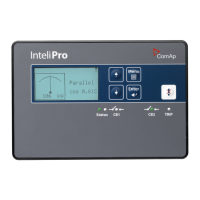InteliPro, SW version 1.0, ©ComAp – May 2011
InteliPro Application Guide
2-10
It is a fast protection, similar to Vector shift, however, unlike Vector shift, which detects immediate
phenomena, the tangent calculation requires a certain time for evaluation. In ComAp protection relays,
the evaluation time for ROCOF protection can be adjusted in number of sine curve cycles being taken
into evaluation from 1 to tens of cycles (each having 20ms). This allows to set up the ratio between the
evaluation speed and sensitivity to nuisance trips.
Overcurrent: definite-time, IDMT and with voltage control
InteliPro provides three types of mains-overcurrent with different setting of the protection delay:
Definite time overcurrent (ANSI 50):
The trip is issued in a given delay after the current exceeds preset limit. The setting is done using the
setpoints
in the group I>.
IDMT overcurrent (ANSI 51)
The IDMT (inverse definite minimum time) overcurrent provides delayed overcurrent trip, based on
calculation of the trip delay according to the trip curve:
I> D
l
The delay, i.e. the IDMT curve shape is prescribed by the DNO, based on the calculations of short-
circuit conditions in the point of the generator connection. The grid protections are coordinated and
allow for isolating the faults by the protections which are located closer to the short-circuit area. This
way, the discrimination of the breakdown point is done by the short-circuit current magnitude allowing
the generator to ride-through a distant faults and contribute to recover the mains voltage after the fault
is disconnected. The setting is done using the setpoints
in the group I> T.
The shape of IDMT curve can be selected using the parameter I> T: I> T Curve. If the option IDMT is
selected, the shape is given by the following formula:
I> De
*
The parameter I> T: I> T Curve allows also to set other switching curves according to the IEC
standards.

